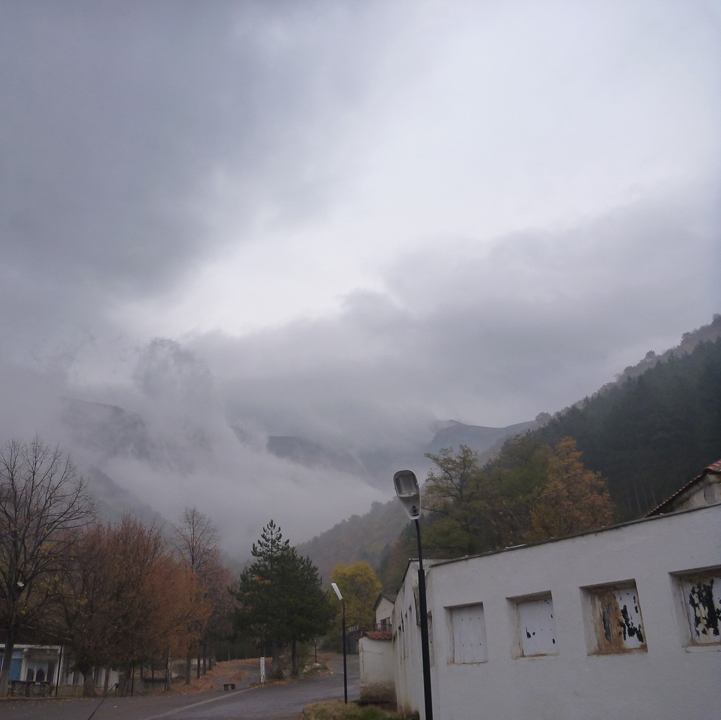You have /5 articles left.
Sign up for a free account or log in.
November 7, 2011: Banjat E Dibrës – Capa, Dibër, Macedonia
By Charlie Hailey
It was getting dark, and my phone alerted me to the SMS text that presumed arrival in Albania: “In Albania to call back to the US dial +1 – area code – number….” License plates in the health spa’s parking lot corroborated the cellular cloud: “AL” under the Albanian two-headed eagle on new BMWs, Mercedes, and Audis. Our more modest Opel rented from Tetova the day before had not crossed any borders, but we had come within four kilometers of Albania for a plunge into the warm sulfur waters of Banjiste.
To reach the baths, we unwittingly followed the course of the river Crn Drin (translated “Black Deer”) as it flows through and out of Lake Ohrid, the deepest lake in Europe. As the river’s waters move north and westward to the Adriatic, Albanian locals travel east for Banjiste’s healing waters. But we learned that the baths’ popularity extends much farther afield: On the women’s side of the baths, my wife and daughter would meet a Chicagoan who returns twice a year, and one ranking system places these springs first in Europe and third in the world for healing and mineral content.
 Despite this global recognition and regional popularity, the dirt roads on the approach are not marked, and we got lost. Three phenomena signaled our path and destination. First we smelled sulfur, then we saw steam rising, wraithlike, cloaking the eight thousand-foot Golem Krchin Mountains. Finally we saw the water, a blue-green rivulet flowing along an impossibly elevated course that looked like a naturally-fabricated tumulus, more roller coaster than aqueduct.
Despite this global recognition and regional popularity, the dirt roads on the approach are not marked, and we got lost. Three phenomena signaled our path and destination. First we smelled sulfur, then we saw steam rising, wraithlike, cloaking the eight thousand-foot Golem Krchin Mountains. Finally we saw the water, a blue-green rivulet flowing along an impossibly elevated course that looked like a naturally-fabricated tumulus, more roller coaster than aqueduct.
The Romans had been here. They too had enjoyed the springs, and Ptolemy included the area as “Deborus” in his second-century mapping of the world. I wondered about two thousand years of constructing nature. It’s as if so many occupations have resulted in a human-made landscape that looks natural. This is a still undeveloped “new” nature waiting for the Lake Ohrid region, the widely publicized eco-tourist destination to the south, to catch up. Yugoslav generals favored these baths, and Banjiste’s dining hall with its grand space and austere furnishings is a relic of those communist times. In the evening, we sat with at least sixty other diners clustered in a far corner, hardly a tenth of the hall’s full occupancy.
This melancholy might have extended to the bathing experience, but the waters don’t abide by the same notions of space and time. Renowned for helping rheumatism, arthritis, eczema, and other ailments, the benefits of the baths are real and imagined. For me, they confirmed a magical realism of the Balkan landscape, a reality that is just that, not denying hardship and conflict but verifying lived experience..jpg)
In my mind, I still can’t bring the spring’s cyan outflow into focus, just as my sketch of the open-air skylight above the bathing pool doesn’t capture the alpine mist twined with sulfur steam. When we were there, my first hope was for another future for the bath, designed perhaps by Peter Zumthor or James Turrell. But as Albanian men happily signaled our shared prescription from the physician who sat between the spa’s lobby and its pools—two hands for my younger son’s ten minutes and three hands for mine—human-scale arches overhead dripped warm condensation, and the folded-plate concrete roof framed the mountain. It was enough.
***
Charlie Hailey teaches design, theory, and history at the University of Florida. His research explores relationships among vernacular architecture, cultural landscapes, and experiences of home. His books include Campsite: Architectures of Duration and Place (LSU Press, 2008) and Camps: A Guide to 21st Century Space (MIT Press, 2009).

